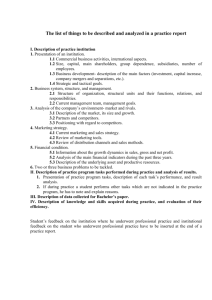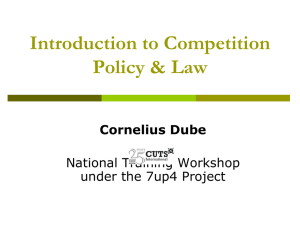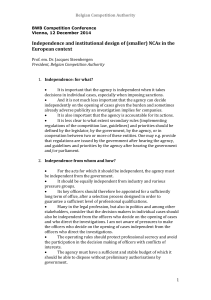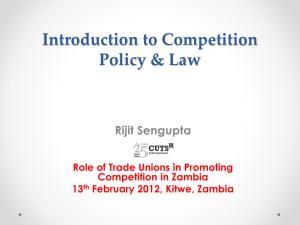The Philippines and Competition Law
advertisement
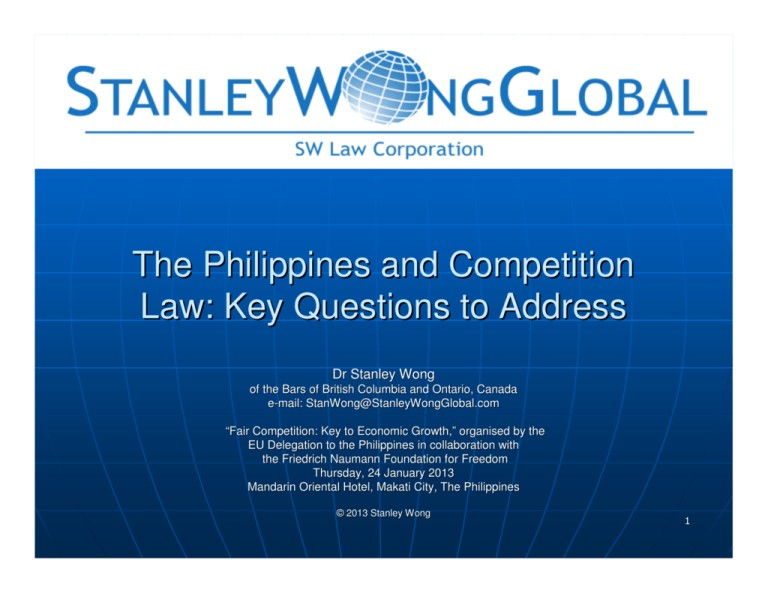
The Philippines and Competition Law: Key Questions to Address Dr Stanley Wong of the Bars of British Columbia and Ontario, Canada e-mail: StanWong@StanleyWongGlobal.com “Fair Competition: Key to Economic Growth,” Growth,” organised by the EU Delegation to the Philippines in collaboration with the Friedrich Naumann Foundation for Freedom Thursday, 24 January 2013 Mandarin Oriental Hotel, Makati City, The Philippines © 2013 Stanley Wong 1 Introduction Competition laws gives effect to the public policy decision to apply market principles to the production and distribution of goods and services in economic sectors Competition laws constitute the main policy tool for securing, preserving and enhancing the benefits of a market economy Competition laws are of general application to all economic sectors 2 Introduction cont’d Over 100 jurisdictions have competition laws • all advanced industrialized countries in North America, Europe and Asia (Japan (1947), Korea (1980)) • emerging countries, e.g. BRICS (Brazil (1994), Russia (2006), India (2002), China (2007) and South Africa (1998); Turkey (1994) • most developing countries in South America, Africa and Asia • of the 10 countries of the ASEAN: Thailand (1999), Indonesia (1999), Lao PDR (2004), Singapore (2004), Vietnam (2004), Malaysia (2010) • few competition laws are more than 25 years old, e.g., Canada (1889), United States (1890), European Union (1957); most have been enacted in the past decade, most recently, Hong Kong (2010) All of this is recognizing the importance of competition laws to securing the benefits of a market economy 3 Introduction cont’d Competition laws establish • norms of business conduct • process for investigation of alleged violations of the norms • process for deciding on whether the norms are violated • sanctions for violations Competition laws are intended to protect competition (competitive process) and not competitors 4 Philippines and Competition Laws The Philippines does not have a comprehensive competition law but has laws dealing with competition • the 1987 Constitution (Article XII, Section 19) prohibits anticompetitive conduct and unfair competition • in addition, some 30 legislative acts deal with competition and related areas The Philippines is committed to enacting competition laws in preparation for the establishment of the ASEAN Economic Community (AEC) in 2015 numerous failed legislative proposals in the past decade to enact competition laws 5 Challenge The challenge for the Philippines is to adopt a competition law regime that fits the country This means the laws should have regard to the • legal system: extent of the rule of law, level of law enforcement, role of the courts • government structure and especially relation between government and ‘regulatory’ bodies • market structure characteristics of the economic sectors • business culture • market economy: importance of present or former state-owned enterprises; scope of sectoral regulation 6 Key Elements The key elements of a set of competition laws • norms relating to conduct collaboration between competitors vertical business relationships, e.g., between supplier and its customers business transactions for mergers and acquisitions • choice of institutional structure • • • • • whether a single body or several bodies to investigate, to enforce and to decide on the merits role of courts to review decisions on the merits exclusions and exemptions conduct of investigations of alleged violations deciding on alleged violations and imposing sanctions right of private action for alleged violations 7 Collaboration between Competitors Competitors are expected to make business decisions, independently of each other Anti-competitive harm caused by collaboration or coordination • • • • increase in prices reduction of output allocation of customers or customer channels reduction of choice Generally, competitors are prohibited from making business decisions in collaboration or in coordination with its competitors in the form of agreements, arrangements or understandings (‘concerted practices’) 8 Competitors cont’d Generally, competitors are prohibited from making business decisions in collaboration or in coordination with its competitors except where there are demonstrable benefits that outweigh any competitive harm, e.g., • collaboration on a research project where no party has the resources to undertake the project alone and limited harm to competition This exception is rarely available where the collaboration or coordination relates to a key parameter of competition such as price, output, customer or customer channels, product choice 9 Vertical Relationships Norms about vertical relationships concerned with dealings between persons at different levels of the production and distribution chain, e.g. supplier and its customers Competitive concern is generally about the extent to which certain conduct under the vertical relationship in question • excludes or disciplines competitors in the supply of the good or service and thereby, harming competition among suppliers • excludes or disciplines competitors in the buying of the good or service and thereby, harming competition among customers 10 Verticals cont’d Conduct under vertical relationships generally does not raise competition concerns unless one of the party is ‘dominant’ • Prohibition against an abuse of a dominant position (Article 102 TFEU) Examples of EU cases on abuse (anti-competitive conduct) • offering rebates and other incentives to discourage customers from buying from a competitor (Intel, computer chips) • non-disclosure by Microsoft of operating protocols, leveraging monopoly in operating systems to server market (Microsoft, server market) • margin squeeze pricing in network industry by supplying services to customers who are also competitors of the supplier (Deutsche Telecom, telephony) 11 Verticals cont’d Vertical relationship not involving a dominant business may raise competition concerns if the vertical relationship facilitates collaboration or coordination among competitors, in which case the law against anticompetitive agreements, etc. are applied (e.g. Article 101 TFEU) • a non-dominant supplier imposes a resale price on its customers that restricts or eliminates competition among its customers 12 Mergers and Acquisitions Most but not all jurisdictions with competition laws review mergers and acquisitions (‘mergers’) • some jurisdictions choose not to enact general provisions dealing with mergers and acquisitions, e.g. Malaysia (2010), Hong Kong (2012) With few exceptions jurisdictions that review mergers and acquisitions impose a notification requirement for mergers that meet certain criteria such as local nexus, turnover or value of assets of the parties or turnover or value of assets involved in the transaction • some jurisdictions review mergers but does not have a notification requirement: UK, Australia, New Zealand, Singapore 13 Mergers cont’d Generally, in a merger review, the question is whether the merger is likely to have an anti-competitive effect • test of significant impediment to effective competition (EU Merger Regulation) which is generally regarded to be similar to the more widely-used substantial lessening of competition test With the exception of U.S. and Canada (and noncompulsory merger review systems), the jurisdiction to review a merger arises only if the transaction in question is required to be notified This is the predominant system in the world: EU, virtually all Member States with merger review (25 of 26), most new competition regimes • may review non-notifiable mergers, e.g. Germany and China 14 Mergers cont’d Very few reviewed mergers raise competition concerns Those that raise competition concerns are rarely prohibited Typically ‘problematic’ mergers are cleared with conditions Typically conditions are negotiated 15 Institutional Structure Enforcing competition laws requires deciding on the institutional structure to investigate, to enforce (prosecute) and to decide There many different institutional models. • Generally, the investigative and enforcement functions reside in a single body or in a single body for most matters except the enforcement of provisions that are criminal • Many jurisdictions have an integrated body with responsibility for all three functions, e.g. European Union • Other jurisdictions combine investigation and enforcement in one body and have another body to make decisions such as a specialized tribunal or a court A key issue is how to ensure fairness in the enforcement process 16 Institutional Structure cont’d A related issue is the nature of the relationship between the competition body (or bodies) with the government • Is the investigative/enforcement body independent of the government? • Is the decision-making body independent of the government? • Can the government overrule the decision-making body? 17 Role of Courts All jurisdictions with competition laws provide that a decision on the merits is subject to review by a court (even where a decision on the merits is made by a court, albeit a different one from the reviewing court) A key issue is the standard of review • To what extent should the reviewing court defer to the expertise of the decision-making body below? Another issue is the powers of the reviewing court • quash the decision below? • make a decision in place of the decision below? remit the matter back to the body below? 18 Exclusions and Exemptions In designing a competition law system, intense pressure to exclude or exempt certain class of persons or certain type of conduct from competition laws (‘we are special’) • Some jurisdictions exclude all conduct by the State; others (e.g. EU) only non-economic activity of the State • Sometimes, all conduct in a certain sector is exempt where the conduct is regulated (‘sectoral exclusion) • Sometimes, a specific activity or conduct that is required or expressly permitted by government or a regulator is exempt (‘regulated conduct’) Generally speaking, the effectiveness of a competition law system is undermined if there are too many exclusions and exemptions: ‘everyone is special’ 19 Conduct of Investigations Typically, an investigative/enforcement body is given investigative powers such as • to demand responses to written information requests and documents • to conduct search of business or private premises to seize documents and to access electronic storage of information • to examine a person under oath The use of these powers, given their intrusive nature, may require prior approval such as a court order for a search warrant or at least a formal order, in the case of an integrated body 20 Decisions and Sanctions Where a decision-making body makes a finding of a violation of a conduct norm or that a merger is anticompetitive, the decision with reasons is made public Requiring the publication of a reasoned decision is an important step in promoting understanding and in fostering respect for the competition law system Sanctions: • purpose: deterrence? punishment? restorative? • types: monetary penalties? conduct orders? 21 Private Right of Action Most jurisdictions provide for a private right of action for a breach of the conduct norms Some jurisdictions allow private actions regarding anticompetitive mergers Some jurisdictions, out of concern about the potential abuse of a private right of action, permit private actions only in respect of conduct for which there has been a public enforcement finding of a violation With the notable exception of the United States, typically a private plaintiff may claim only compensatory damages, sometimes also punitive or exemplary damages, and injunctive relief 22 Obstacles Among the greatest obstacles to embedding a culture of competition • lobbying by special interests groups • rivalry among government bodies to exempt certain sectors from competition laws • actions and attitudes about competition of government bodies such as departments/ministries and sectoral regulators 23 The End 24
